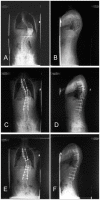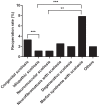Unplanned reoperation within 30 days of fusion surgery for spinal deformity
- PMID: 24595145
- PMCID: PMC3942308
- DOI: 10.1371/journal.pone.0087172
Unplanned reoperation within 30 days of fusion surgery for spinal deformity
Abstract
No recent studies have analyzed the rates of or reasons for unanticipated revision surgery within 30 days of primary surgery in spinal deformity patients. Our aim was to examine the incidence, characteristics, reasons, and risk factors for unplanned revision surgery in spinal deformity patients treated at one institution. All patients with a diagnosis of spinal deformity presenting for primary instrumented spinal fusion at a single institution from 1998 to 2012 were reviewed. All unplanned reoperations performed within 30 days after primary surgery were analyzed in terms of demographics, surgical data, and complications. Statistical analyses were performed to obtain correlations and risk factors for anticipated revision. Of 2758 patients [aged 16.07 years (range, 2-71), 69.8% female] who underwent spinal fusion surgery, 59 (2.1%) required reoperation within 30 days after primary surgery. The length of follow up for each patient was more than 30 days. Of those that required reoperation, 87.0% had posterior surgery only, 5.7% had anterior surgery, and 7.3% underwent an anteroposterior approach. The reasons for reoperation included implant failure (n = 20), wound infection (n = 12), neurologic deficit (n = 9), pulmonary complications (n = 17), and coronal plane imbalance (n = 1). The risk factors for reoperation were age, diagnosis, and surgical procedure with osteotomy.
Conflict of interest statement
Figures




Similar articles
-
Revision rates following primary adult spinal deformity surgery: six hundred forty-three consecutive patients followed-up to twenty-two years postoperative.Spine (Phila Pa 1976). 2010 Jan 15;35(2):219-26. doi: 10.1097/BRS.0b013e3181c91180. Spine (Phila Pa 1976). 2010. PMID: 20038867
-
Unplanned Hospital Readmissions and Reoperations After Pediatric Spinal Fusion Surgery.Spine (Phila Pa 1976). 2015 Jun 1;40(11):856-62. doi: 10.1097/BRS.0000000000000857. Spine (Phila Pa 1976). 2015. PMID: 26091156
-
Reoperation rates and impact on outcome in a large, prospective, multicenter, adult spinal deformity database: clinical article.J Neurosurg Spine. 2013 Oct;19(4):464-70. doi: 10.3171/2013.7.SPINE12901. Epub 2013 Aug 23. J Neurosurg Spine. 2013. PMID: 23971763
-
Pseudarthrosis in adult and pediatric spinal deformity surgery: a systematic review of the literature and meta-analysis of incidence, characteristics, and risk factors.Neurosurg Rev. 2019 Jun;42(2):319-336. doi: 10.1007/s10143-018-0951-3. Epub 2018 Feb 6. Neurosurg Rev. 2019. PMID: 29411177
-
Fate of the adult revision spinal deformity patient: a single institution experience.Spine (Phila Pa 1976). 2013 Sep 1;38(19):E1196-200. doi: 10.1097/BRS.0b013e31829e764b. Spine (Phila Pa 1976). 2013. PMID: 23759813 Free PMC article. Review.
Cited by
-
Complications After Adult Spinal Deformity Surgeries: All Are Not Created Equal.Int J Spine Surg. 2021 Feb;15(1):137-143. doi: 10.14444/8018. Epub 2021 Feb 12. Int J Spine Surg. 2021. PMID: 33900967 Free PMC article.
-
Emerging roles of non-coding RNAs in scoliosis.Cell Prolif. 2020 Feb;53(2):e12736. doi: 10.1111/cpr.12736. Epub 2019 Dec 12. Cell Prolif. 2020. PMID: 31828859 Free PMC article. Review.
-
Unplanned reoperation after radical surgery for oral cancer: an analysis of risk factors and outcomes.BMC Oral Health. 2022 May 25;22(1):204. doi: 10.1186/s12903-022-02238-7. BMC Oral Health. 2022. PMID: 35614416 Free PMC article.
-
A novel probe for measuring tissue bioelectrical impedance to enhance pedicle screw placement in spinal surgery.Am J Transl Res. 2018 Jul 15;10(7):2205-2212. eCollection 2018. Am J Transl Res. 2018. PMID: 30093957 Free PMC article.
-
Incidences, causes and risk factors of unplanned reoperation within 30 days of craniovertebral junction surgery: a single-center experience.Eur Spine J. 2023 Jun;32(6):2157-2163. doi: 10.1007/s00586-023-07729-x. Epub 2023 May 4. Eur Spine J. 2023. PMID: 37140641
References
-
- Wiggns GC, Rauzzino MJ, Bartkowski HM, Nockels RP, Shaffrey CI (2001) Management of complex pediatric and adolescent spinal deformity. J Neurosurg 95: 17–24. - PubMed
-
- Lykissas MG, Jain VV, Nathan ST, Pawar V, Eismann EA, et al. (2013) Mid- to long-term outcomes in adolescent idiopathic scoliosis after instrumented posterior spinal fusion: a meta-analysis. Spine (Phila Pa 1976) 38: E113–119. - PubMed
-
- Liang CZ, Li FC, Li H, Tao Y, Zhou X, et al. (2012) Surgery is an effective and reasonable treatment for degenerative scoliosis: a systematic review. J Int Med Res 40: 399–405. - PubMed
-
- Charosky S, Guigui P, Blamoutier A, Roussouly P, Chopin D (2012) Complications and risk factors of primary adult scoliosis surgery: a multicenter study of 306 patients. Spine (Phila Pa 1976) 37: 693–700. - PubMed
Publication types
MeSH terms
LinkOut - more resources
Full Text Sources
Other Literature Sources

